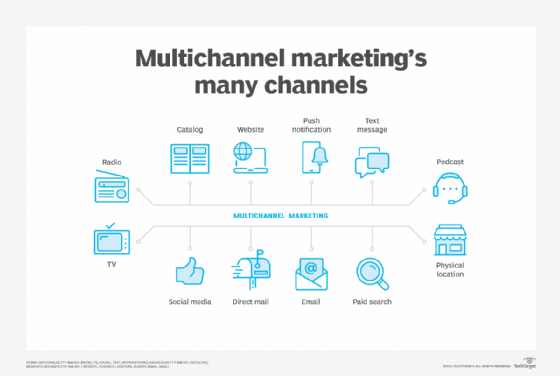
kras99 - stock.adobe.com
Create a video marketing strategy in 10 steps
Video content can quickly engage people and reach broader audiences. A successful video marketing strategy should embrace different types of videos and SEO best practices.
Video has become one of the most effective tools for marketing teams to engage target audiences.
Many marketers have embraced video in their campaigns to keep up with a growing consumer preference for multimedia and short-form content, like TikTok videos, Instagram Reels and YouTube Shorts. Marketers use video for its popularity but also because it can increase sales and drive significant ROI.
As video adoption has grown, so have the tools that support it. For example, modern marketing teams have access to intuitive editing platforms, AI captioning, automated resizing, cloud-based collaboration tools and advanced analytics. The availability of these tools reduces production barriers and enables high-quality output, even for small teams. However, as competition intensifies, success requires a well-crafted video marketing strategy.
Key steps to create a video marketing strategy include the following:
- Identify goals.
- Understand the target audience.
- Learn about different video types.
- Benchmark competitors.
- Develop a content plan and calendar.
- Embrace search engine optimization (SEO).
- Define and track key metrics.
- Incorporate strong calls to action.
- Promote videos across channels.
- Test, learn and optimize.
An effective video marketing strategy requires clear goals and alignment with broader business objectives. The following steps can guide marketers through planning, creation and distribution.
1. Identify goals
Every strong video marketing strategy begins with a clear understanding of objectives. Whether the aim is to increase brand awareness, drive website traffic, boost social media engagement or generate conversions, marketers should set specific goals to effectively shape the content and distribution approach.
Why it matters
Goals offer clear direction and make it possible to measure success through relevant metrics. Without them, video campaigns can become directionless and ineffective.
How to execute
Marketers can use the SMART goal framework -- a structured approach to goal setting that creates specific, measurable, achievable, realistic and time-bound goals. For example, rather than a goal to simply increase engagement, marketers can set a goal to increase Instagram video views by 20% over the next three months. Marketers should also align goals with broader marketing and overall business priorities to ensure all tactics drive meaningful outcomes.
2. Understand the target audience
Organizations require a deep understanding of the target audience to create video content relevant to their interests and needs. Marketers should know who the audience is, what they care about, where they spend time online and how they consume videos because this data can inform decisions about messaging, tone and distribution.
Why it matters
Videos that fail to connect with the right audience are unlikely to achieve meaningful results, regardless of production quality.
How to execute
Marketers should use customer data, surveys, social listening tools and website analytics to conduct audience research. They can identify key demographics, interests, pain points and preferred platforms. Additionally, marketers can create buyer personas to guide video development.

3. Learn about different video types
Different video types serve different purposes. For instance, educational explainer videos can help build brand awareness, whereas emotional customer testimonials generate trust. Marketers should understand which formats best match their goals and audience preferences.
Why it matters
Choosing the right video format increases the likelihood of audience engagement and strengthens the overall strategy.
How to execute
Marketers can review common video types, such as the following:
- Product demos. Showcase features and benefits.
- How-to videos. Educate viewers.
- Testimonials. Build trust and credibility.
- Live videos. Generate real-time interactions with customers.
- Behind-the-scenes videos. Humanize the brand.
To create effective video content, marketers should select formats that align with objectives and audience expectations. They can also test multiple formats to identify which performs best.
4. Benchmark competitors
Marketers can analyze competitor activity to gain valuable insights into what works within the industry. Benchmarking reveals content gaps, engagement tactics and potential differentiation points.
Why it matters
Understanding the competitive landscape helps marketers avoid content duplication, identify effective video topics and set realistic performance benchmarks.
How to execute
Marketers can identify top competitors and review their video content across platforms such as YouTube, TikTok, LinkedIn and Instagram. They can assess video types, engagement levels, publishing frequency and audience responses. These insights can help marketing teams refine their strategy and highlight areas for innovation and improvement.
5. Develop a content plan and calendar
A content plan ensures consistency and alignment with marketing goals, whereas a calendar outlines when and on which channels the organization publishes videos.
Why it matters
Without a plan, video marketing efforts can become scattered. This reduces campaign effectiveness and wastes resources.
How to execute
Marketers can map out key themes, campaigns and time-specific marketing opportunities, such as holidays and seasonal promotions. They can also develop a calendar that details production timelines, publishing dates and distribution channels. Additionally, they should coordinate video content with other marketing initiatives to ensure the videos support larger efforts.
6. Embrace SEO
Videos can improve a brand's visibility on search engines but only if marketers use SEO best practices. SEO increases the likelihood that people will discover content through search engines, such as Google, or a platform's algorithms, such as YouTube's or TikTok's internal search functions.
Why it matters
Videos optimized for search engines drive more organic traffic and improve ROI. This approach expands a brand's reach yet doesn't require additional advertising spend.
How to execute
Marketers should incorporate relevant keywords in video titles, descriptions and tags to help search engine algorithms accurately index and categorize videos. They should also add transcripts or closed captions to improve accessibility and indexing. Additionally, marketers can use engaging thumbnails and include clear metadata. For website-embedded videos, they should optimize surrounding page content and ensure fast load times to enhance SEO performance.

7. Define and track key metrics
Organizations can use metrics to track video performance and identify opportunities for further optimization. However, marketers must establish KPIs that align with their campaign's goals to make sure their content meets them.
Why it matters
Tracking the right metrics offers actionable insights to help marketers improve video performance over time. It increases audience engagement and demonstrates effective marketing budget allocation.
How to execute
Marketers should choose KPIs, such as views, watch time, click-through rates, social shares, conversions and engagement rates, depending on objectives. Many video and social media platforms have built-in social media analytics tools, such as YouTube Analytics and Meta Insights. Organizations can also integrate these platforms with broader marketing analytics systems. They should regularly review performance data to identify trends and adjust strategies as needed.
8. Incorporate strong calls to action
Effective videos lead viewers toward the desired next step, whether that's subscribing to a channel, visiting a website or making a purchase. Calls to action (CTAs) -- sentences that begin with a verb and prompt audiences to take action -- offer that direction.
Why it matters
Without clear CTAs, even the most engaging videos may fail to convert viewers into leads or customers.
How to execute
Marketers can incorporate CTAs both within the video content and in surrounding elements, such as captions, descriptions and end screens. They should make CTAs clear, compelling and align them with the video's purpose. The following are some examples:
- Download the guide.
- Subscribe for updates.
- Book a demo.
9. Promote videos across channels
Simply uploading a video is not enough effort to reach audiences and compete in crowded markets. Instead, marketers must actively promote content to maximize reach and engagement.
Why it matters
Cross-channel promotion amplifies video exposure and increases the chances of achieving campaign objectives.
How to execute
Marketers should share videos across relevant social media platforms, embed them in website pages and blogs, include them in email marketing campaigns and explore paid promotion options. Additionally, they should tailor messaging and formats to fit each channel's unique requirements and audience behaviors.

10. Test, learn and optimize
Video marketing strategies require frequent updates. They evolve based on performance insights and audience feedback, and continuous testing and refinement can improve results over time.
Why it matters
Ongoing optimization helps video marketing efforts remain effective and aligned with changing audience preferences and market conditions.
How to execute
Marketers can conduct A/B testing on various elements, such as video length, thumbnail images, headlines and CTAs. They can analyze performance data to identify high-performing content and replicate successful tactics. Additionally, marketers should solicit audience feedback to uncover qualitative insights and integrate learnings into future video production and strategy decisions.
An effective video marketing strategy requires careful planning, execution and refinement. However, it can help marketers create video content that resonates with audiences, achieves the brand's goals and delivers measurable outcomes, such as increased conversion rates and ROI. Each component -- from goal setting and audience research to SEO and promotion -- helps maximize the effectiveness of video marketing efforts.
Griffin LaFleur is a MarketingOps and RevOps professional working for Swing Education. Throughout his career, LaFleur has also worked at agencies and independently as a B2B sales and marketing consultant.







